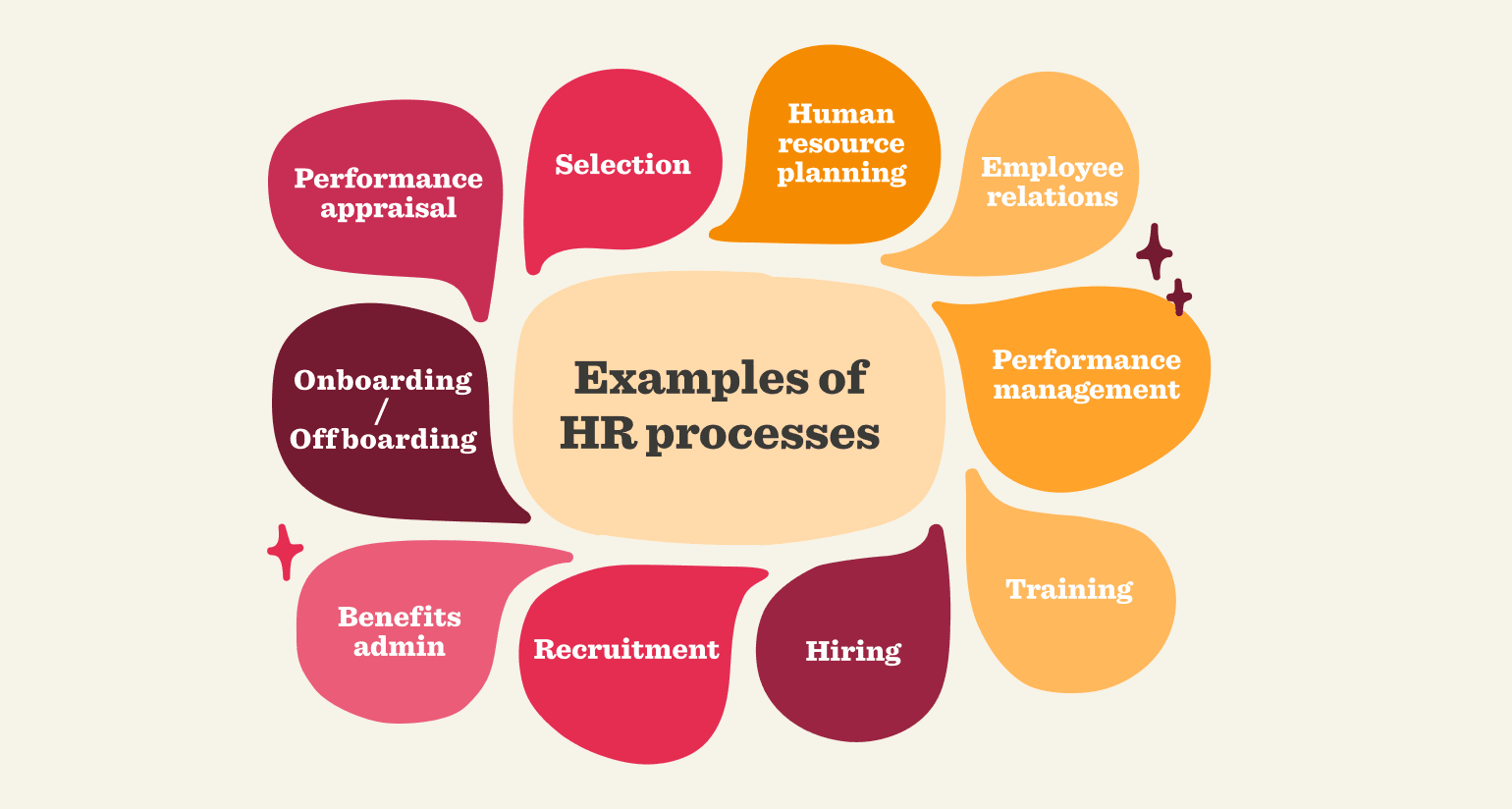HR processes refer to the fundamental strategies necessary to support the employee lifecycle and a positive employee experience.
Successful companies often rely on systems that keep things running smoothly, from managing talent to ensuring compliance. These systems create order, improve efficiency, and provide the structure that allows businesses to thrive as they scale.
Behind these systems are critical HR processes that help maintain a positive work environment, engage people, and drive long-term success. HR processes make it easier for HR professionals to manage their tasks and for team members to understand expectations and internal workflows.
From recruitment and onboarding to performance management and compliance, streamlined HR processes can transform how your business operates—making everything smoother, more transparent, and productive. By understanding and refining these processes, your HR team can focus on what matters: empowering your people and supporting your company’s success.
What are HR processes?
HR processes refer to the fundamental strategies necessary to support the employee lifecycle and a positive employee experience. Each HR process follows an intricate pathway that demands strategic planning according to specific parameters and objectives. While every process involves its own procedures, the processes are interdependent.
Key takeaways
- An HR system like HiBob helps streamline and automate HR processes, ensuring consistency and efficiency across recruitment, onboarding, performance management, benefits administration, and offboarding.
- Well-structured HR processes enhance efficiency, improve compliance, boost employee engagement, and contribute to a positive workplace culture.
- HR process automation reduces administrative burdens, minimizes errors, accelerates workforce planning, and improves employee self-service capabilities.
- The difference between HR processes and HR systems is that HR processes define the strategies and workflows, while HR systems provide the technological framework to manage them effectively.
- Implementing best practices such as goal alignment, automation, flexibility, and employee feedback ensures HR processes stay relevant and effective.
- Businesses that streamline HR processes can increase productivity, enhance retention, and build a more scalable and people-centric organization.
Why should HR leaders care about HR processes?
HR processes serve as an organization’s arteries, carrying the lifeblood to every department and nurturing company-wide health. Systemic approaches can help HR leaders promote efficient processes, thereby boosting productivity, retention, and engagement in the workplace.
Examples of HR processes
Core HR processes involve activities that HR teams actively manage to support and develop team members effectively. Each process is important in ensuring the organization runs smoothly, and people receive the support they need throughout their employment.
Here’s how HR teams take action in these key areas:
- Human resource planning: HR teams can forecast staffing needs by analyzing business goals and market trends. They assess current workforce capabilities, identify skill gaps, and develop strategies to meet future demands.
- Recruitment: Recruitment involves actively searching for and attracting qualified candidates to fill open positions. HR teams create job postings, source candidates, and engage with potential hires through various channels.
- Selection: Selection involves evaluating applicants to identify the best fit for each role. HR teams review resumes, conduct interviews, and administer assessments to select suitable candidates.
- Hiring: HR teams manage the offer process, negotiate terms, and finalize hiring agreements, ensuring compliance with legal and organizational requirements.
- Onboarding: Managers and HR introduce new hires to the organization, providing them with the tools, resources, and information needed to succeed. They make sure new joiners integrate quickly and feel welcomed.
- Training: Training involves developing and delivering learning programs that enhance people’s skills and knowledge. HR teams ensure ongoing training to keep people aligned with industry trends and organizational needs.
- Employee relations: This involves managing the relationship between the organization and its team members. HR teams address issues, answer questions, and foster a positive work environment.
- Performance appraisals: Performance appraisals involve evaluating performance, providing continuous feedback, setting goals, and identifying areas for improvement. HR teams conduct performance reviews regularly to align individual contributions with organizational objectives.
- Benefits administration: HR teams oversee and manage benefits, including health insurance, retirement plans, and other perks, ensuring that people receive the support needed for their wellbeing.
- Performance management: HR teams track professionals’ work performance and develop their skills so they can contribute effectively toward department and company goals.
- Offboarding: Offboarding involves managing the process of people leaving. HR teams conduct exit interviews, process final payments, and ensure a smooth transition for leavers.

How do HR processes work?
Let’s take an in-depth look at performance management as an example. Performance management involves evaluating people’s work effectiveness, quality, and efficiency while offering performance improvement options through coaching and training.
As an HR process, performance management encompasses:
- Establishing a clear company vision
- Setting realistic personal goals
- Continuously providing constructive feedback
- Offering upskilling opportunities
To design an effective performance management process, HR must first ensure alignment between leadership and each department’s organizational strategy, design a credible and transparent performance management system, and create an appropriate framework for completing each step. Performance management templates can keep the reviews streamlined and consistent.
Only then can HR start the performance management process of planning, checking in with professionals, and reviewing their job performances.
HR processes vs. HR systems
An HR system refers to a unified whole made up of interdependent HR processes. An HR management system encompasses all HR processes, creating a cohesive unit so the company can manage its workforce and deliver valuable services or goods to its customers. Today, most HR systems are software-based and involve digital automation.
What is end-to-end HR process management?
End-to-end HR process management means that HR is responsible for carrying out every people-related process from start to finish. Process management is comprehensive and involves breaking down tasks into smaller steps so the process flows smoothly.
For example, end-to-end onboarding does not involve a mishmash of duties HR teams must accomplish at some point. Rather, onboarding demands a sequence of actions to take at the beginning and end of the process. The initial stages may include emailing a job offer to the candidate, completing new-hire paperwork, and sending an informational welcome package.
In contrast, the final stages may involve emailing the onboarding schedule to the team manager and scheduling a welcome meeting for the new joiner.
Benefits of HR process automation
HR process automation assists companies in their HR processes, such as recruiting, hiring, paying, upskilling, and offboarding their people. Automation brings HR processes to the next level while also improving:
Efficiency
HR teams can use automated tools to eliminate time-consuming tasks like data entry, team member onboarding, and updating records. For instance, HR teams might use an onboarding software platform that automatically sends welcome emails, assigns training programs and courses, and schedules orientation meetings.
This allows HR teams to shift their focus from repetitive, manual tasks to more strategic initiatives. For example, instead of personally guiding a new hire through each onboarding step, HR teams can automate some of the process with software that automatically tracks progress and documentation management.
HR professionals can use the time they save to implement culture-building activities with the new hire, like setting up a one-on-one lunch between the new joiner and their direct manager, organizing a small group meet-and-greet with key team members, or hosting a virtual introduction session for remote hires. This can help the new person feel more connected from day one.
Workforce planning
HR uses workforce planning to ensure the business consistently has the right number of people with the right skills, while also preparing for succession planning. Effective workforce planning requires insights and analytics to enable data-driven decisions.
Automation tools can project future staffing needs by analyzing metrics such as average work hours per week, turnover rates, and productivity rates against the existing workload.
By automating data analysis, HR can identify skill gaps, assess performance, and select the best candidates for top roles, ensuring a well-prepared and skilled workforce.
Recruitment
Consider the mental effort and time required to review hundreds of CVs, respond to applicants, and schedule interviews. HR teams can automate these processes using an all-in-one human capital management (HCM) system that includes recruiting capabilities. These platforms can manage the entire hiring process in one place, from creating new job openings, scheduling interviews, evaluating candidates with custom scorecards, and sending offer letters.
HR teams can use the software to uncover insights about where their most successful hires come from—whether a specific job board or a referral.
Employee retention and experience
McKinsey research shows that organizations with positive workplace experiences have lower churn rates and are 1.3 times more likely to outperform other companies.
HR teams can improve experiences by offering self-service systems that allow people to access HR services anytime, from anywhere, without needing to contact HR directly.
This way, team members can easily retrieve records, update personal information, view paycheck history, and submit leave requests. This direct access to HR information and tools empowers people to address their needs quickly, resolving questions and improving their overall work experience.
Compliance with labor laws
Automated HR software can help HR teams generate locally or globally compliant contracts, fill out all necessary documentation, and stay updated on labor law changes. This ensures compliance with changing regulations and reduces the risk of noncompliance penalties.
Reduced margin of error
HR process automation can reduce the likelihood of manual errors. By automating data entry, calculations, tracking deadlines, and other key processes, HR teams can minimize mistakes and improve accuracy and efficiency–positively impacting the organization’s bottom line.
For example, automating payroll processing can ensure accurate tax calculations and timely payments, reducing the risk of human error that could lead to fines, compliance issues, or delayed salaries. This saves time and improves employee satisfaction since people trust that the payroll team handles their pay and benefits correctly and on time.
Best practices for managing HR processes
HR leaders can incorporate the following methods into their approach to process management:
Review objectives
HR leaders can regularly check that process objectives align with company goals. Reassessing by asking a series of goal-oriented questions allows HR to ensure they’re progressing in the desired direction.
Let automation do its job
HR tech automation helps processes function more smoothly. For instance, team members and managers can use task lists instead of handwriting an infinite number of items on a to-do list. These remind people of their responsibilities while simultaneously allowing for convenient back-and-forth collaboration.
Tech automation facilitates this crucial communication between professionals during processes such as onboarding, offboarding, and transfers.
Maintain flexibility within the framework
Using tried-and-tested management methods can help HR track progress, pinpoint areas for improvement, and redesign practices for better functioning. While a data-based framework provides structure and guidance, HR deals with humans, so there must be room for flexibility, critical thinking, and differing perspectives.
Within each HR process, HR can continuously assess its workforce data to ensure it consistently and accurately reflects its people.
Recommended For Further Reading
Listen to your people
Individuals offer wellsprings of advice, information, and experience about how HR can better adjust process components. After running an employee satisfaction survey or a performance review with multi-directional feedback, HR professionals can improve processes internally.
Enhance your company culture with streamlined HR processes
Streamlined HR processes play a crucial role in maintaining continuous workplace productivity. As people are the most valuable asset of any company, creating a positive employee experience is essential.
Automate your HR processes with the right HR software that reduces administrative burdens, improves accuracy, and frees up time for more meaningful team member interactions. This efficiency directly contributes to job satisfaction, engagement, and productivity—key elements that strengthen and sustain a robust company culture.
APA Citation (7th Ed.)
HiBob Glossary. https://www.hibob.com/hr-glossary/hr-processes/
